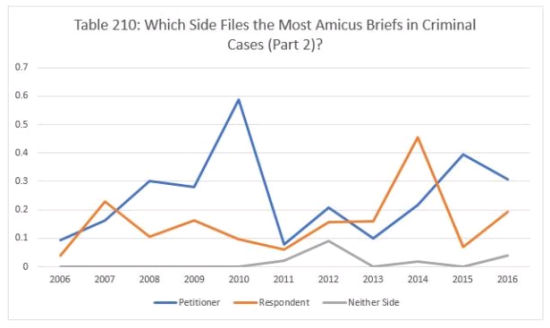Yesterday, we looked at the court's experience with amicus briefs in criminal cases for the first half of our study period, 1994-2005. Today, we look at the data for the second half of the period.
For the most part, the relationship between the sides was the same – petitioners tend to get more amicus support in criminal cases than do respondents. In 2006, amicus briefs were quite rare on the criminal side – 0.09 per case supporting petitioners to 0.04 for respondents. In 2007, petitioners averaged 0.16, while respondents got the support of 0.23 briefs per case. In 2008, petitioners averaged 0.3 briefs per case to 0.11 for respondents. In 2009, petitioners were down slightly, averaging 0.28 briefs per case, while respondents averaged 0.16. In 2010, briefs supporting petitioners reached their highest level of the period, as petitioners averaged 0.59 amici per case. Respondents averaged 0.1.
2011 was another very light year – petitioners averaged 0.08 briefs, while respondents averaged 0.06. Amici were up a bit on both sides in 2012 – 0.21 briefs for petitioners and 0.16 for respondents. In 2013, petitioners averaged 0.1 amicus briefs per case to 0.16 for respondents. In 2014, petitioners averaged 0.22 amici per case to 0.46 for respondents. In 2015, petitioners averaged 0.4 briefs per case, and respondents dropped to almost nothing, averaging only 0.07 amici per case. Last year, petitioners averaged 0.31 amici per case, while respondents averaged 0.19.

Join us back here next Thursday as we continue our examination of the Court's experience with amicus briefs.
The content of this article is intended to provide a general guide to the subject matter. Specialist advice should be sought about your specific circumstances.

